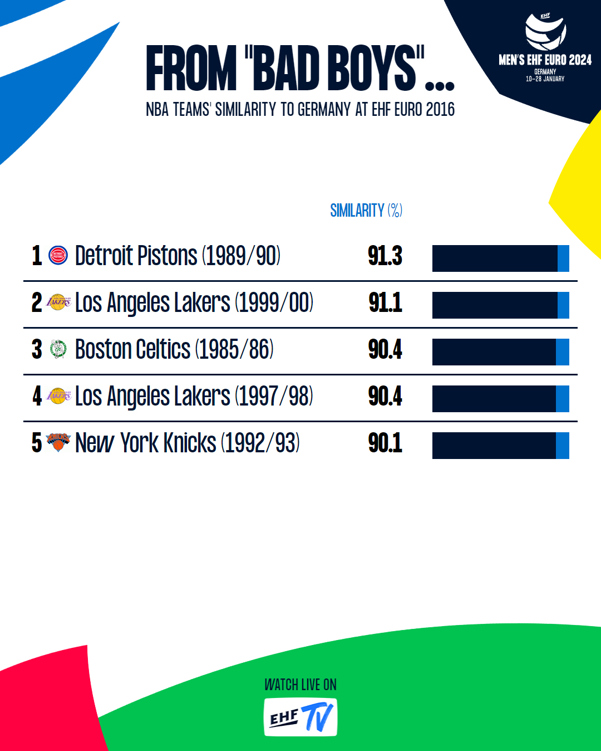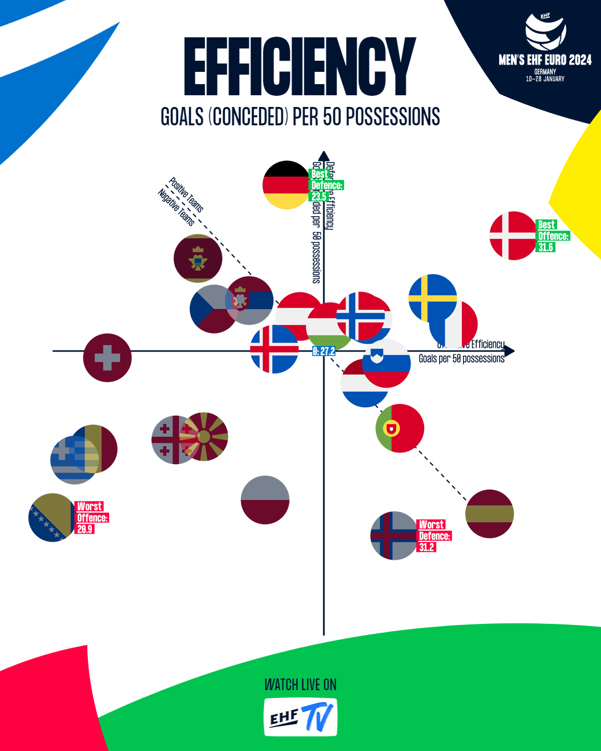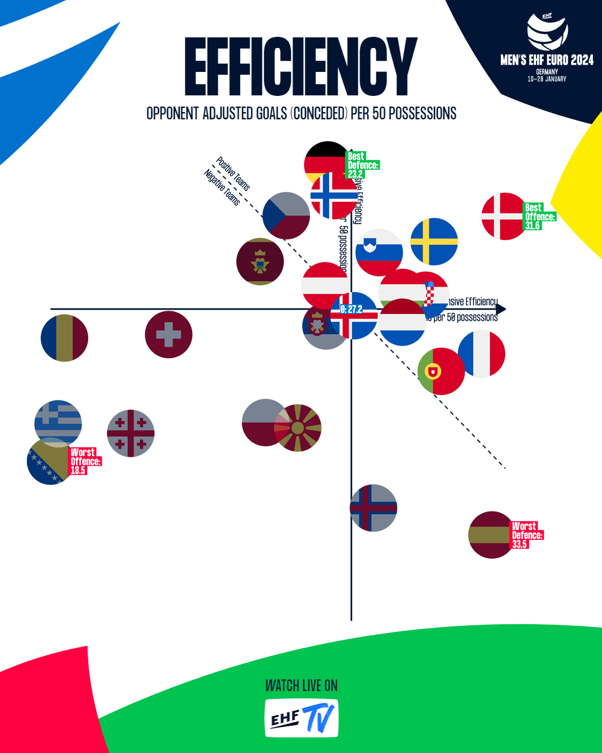In 2016, when Germany surprisingly won the EHF EURO, the team received the nickname "Bad Boys" because coach Dagur Sigurdsson modelled them after the Detroit Pistons who were known as "Bad Boys" in the late 80s and early 90s. He showed his team videos and told stories from the basketball team that was notorious for their tough and defence-oriented style of play.
On the one hand, the question naturally arises as to what extent Sigurdsson's "Bad Boys" resembled the original from a statistical point of view. On the other hand, this raises the question which NBA team the current German national team – back in the semi-finals of the EHF EURO for the first time since 2016 – is.
The criteria
To do this, the most important comparable statistics from both sports were selected. General offense and defence are evaluated in the NBA by offensive and defensive rating which is points scored or conceded by 100 possessions. The similar metric in handball is goals scored and conceded by 50 possessions. The difference between both is the so-called net rating which is an indicator for overall strength.
Adjusting for possessions played is significantly more meaningful than just the raw number of goals (conceded) because it makes teams actually comparable since the raw number of goals is not only influenced by efficiency but also by the number of possessions (whether a team and their opponents play rather fast or slow).
Since at the EHF EURO not all teams play against each other, these three metrics were adjusted for opponent strength as well. The adjustment is done by calculating how many goals (conceded) per 50 possessions would be expected for each game and team by the number of goals the opponents scored and conceded per 50 possessions in their other games. The differences to the actual goals scored and conceded can then be added to the goals scored or conceded per 50 possessions to have an adjusted rating.
In addition, garbage time is filtered out in the adjusted ratings. Garbage time is when the game is out of hand, and both teams have subbed out most of their most important players. The exact definition that is used here is if there are 15 or less minutes to play and the score difference is at least ten or if there are then or less minutes to play and the score difference is at least seven or if there are five and less minutes to play and the score difference is at least five. This is of course not a perfect definition and might not capture all of what is called garbage time, but it’s of course important to not mistakenly filter out any game time that’s no actual garbage time.
Besides, in the comparison of the NBA and EHF EURO teams more detailed statistics were used such as the effective shooting percentage (which accounts for three-point shots), the offensive rebound percentage (share of missed shots that were rebounded by the offensive team) and the turnover percentage (share of possessions ended by a turnover) in basketball. The handball equivalents are field shooting percentage and as well the offensive rebound percentage and turnover percentage. The same statistics are used vice versa for defence.
To reflect style of play pace (number of possessions per 60 minutes) was used for both sports. As the "Bad Boys" were not called that for nothing, fouls in basketball and the equivalent suspension minutes in handball were also considered. Finally, the result at the end of the tournament played a role as well.
For the NBA data is available since 1980 and only regular season data was used. Data from the EHF EURO is available for all these metrics since 2016. In each 12 categories of both sports the maximum value got 100 per cent attributed and the minimum 0 per cent. The differences of the percentages in each category were then calculated and the smaller the average of the absolute differences the bigger the similarities between the NBA team and the EHF EURO team.
Actually "Bad Boys" in 2016
Fittingly, the equivalent for the German "Bad Boys" from 2016, were by the data actually the Detroit Pistons "Bad Boys" from the season (1989/90). Their statistical similarity is 91.3 per cent, more than with any other NBA team.

The 1989/90 Pistons won the NBA Championship as Germany won EHF EURO 2016. But there are of course many more similarities. In particular, there are big statistical similarities at the offensive and net rating. Neither group of "Bad Boys" had the best offence of their competition: with 109.9 points per 100 possessions, the Pistons ranked just 11th amongst 27 NBA teams in 1989/90 but over all seasons were clearly above average. Germany had the fourth-best offence of 16 teams in 2016 with opponent adjusted 27.8 goals per 50 possessions.
Defensively Germany had the third-best defence with 24.5 goals conceded per 50 possessions while the original "Bad Boys" ranked second with 103.5 points conceded per 100 possessions. Both at the NBA and the EHF EURO, offensive numbers have improved while defensive statistics have deteriorated accordingly in the last years. The net between these two ratings was then 6.4 for the Pistons and 3.1 for Sigurdson’s team, both third-best in their competition.
Even closer is pace, where they differ by just 0.8 percentage points. Germany’s 50.4 possessions per 60 minutes were the fourth slowest games. With 94.4 possessions per 48 minutes the Pistons were even the second slowest team in 1989/90.
In addition, turnover numbers on both sides are extremely similar. Some 19.5 per cent of Germany’s possessions ended with a lost ball (seventh best), while 13.4 per cent for Detroit ranked them ninth. They themselves forced fewer than average turnovers. The Pistons ranked 15th with 13.7 per cent, while Germany were 11th with 18.3.
"Kings" in 2024
At EHF EURO 2024 Germany have impressed with their strong defence, while they have problems in offence. Based on the normal goals per 50 possessions they rank just 13th with 26.3, which is below the average of 27.1. Adjusted to opponent strength, the number slightly improves to 26.5, but remains below average.


Defensively, however, they clearly rank first by goals conceded per 50 possessions with 23.5. Adjusted for opponent strength that number improves even to 23.2 and is the best number since Spain in 2020.
The most similar NBA team to these and the other considered stats are the Sacramento Kings from the NBA season 2001/02 with a similarity score of 89.7 per cent. Interestingly, the Kings teams from the season after and before rank second and fourth.

The similarities to the Kings from 2001/02 are especially high in the offensive rating where they ranked fourth with 109.0. Since the NBA offences have clearly improved since then, over all considered seasons it is around average as well and almost exactly corresponds the current German offensive performance.
For goals or points conceded the difference is a bit bigger because even though Sacramento wasn’t as good as they just ranked sixth in 2001/02 with 101.1 per 100 possessions. The net between offence and defence for Alfred Gislason’s team is unadjusted 2.8 (fourth best) and adjusted 3.3 (third best). The similarity to the Kings who were second best with 7.9 is very high as over all considered competitions/seasons both are good but not very good.
There are also high similarity values for the rebounding numbers as both are below average rebounding teams. The Kings rebounded 27.9 per cent of their own misses and 70.7 per cent of their opponents’ misses, while Germany gets 16.5 per cent of their own missed shots and 80.0 per cent of their opponents’. All these numbers are very average.
In the end, the Sacramento Kings narrowly lost in the Western Conference Final, i.e. the semi-final of the NBA playoffs, by 4:3 won games to the eventual champions, the Los Angeles Lakers. It will be very interesting to see whether the EHF EURO 2024 will be similar to the 2001/02 NBA season in that as well.
More from data analyst Julian Rux can be found at Handballytics.de. There you can read his latest articles, in which he analyses all kinds of handball topics from new, data-based perspectives. You can also find him on Instagram, Facebook, X and WhatsApp Channels.
Photos © Kolektiff Images










